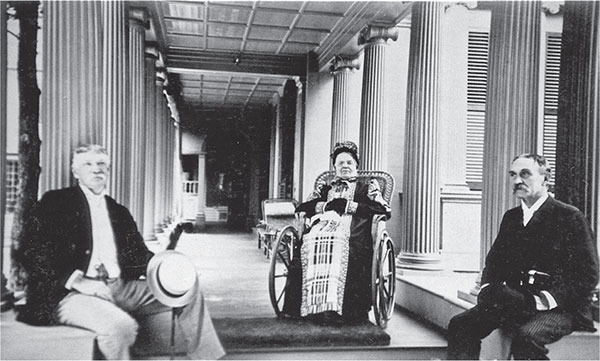
Edward Searles (left) with his elderly mother (center). City of Methuen Archives.
15
EDWARD FRANCIS SEARLES
They say—what say they? Let them say.
Above is the personal motto of Edward Francis Searles, a man who went from rags to riches, from working in mills to building lavish castle estates. He was born on the Fourth of July in 1841 in Methuen, Massachusetts, to parents Jessie Gould Searles and Sarah Littlefield Searles. His father, a farmer and superintendent at a local cotton mill, passed away when Searles was only two years old. The family could not survive long on any assets that Sarah might have had, so she was forced to send Edward and his brother, Andrew, to work in the cotton mill as soon as they were old enough.
With money from selling part of the family farm and from Edward working in local cow pastures, as well as at the mill, Sarah was able to pay for her son to take piano lessons in Lawrence, Massachusetts. Edward developed an interest in the piano and went on to study organ music in Boston, later teaching piano and organ. When household chores became too much for Sarah, she decided to find a young girl to help with housekeeping. Not having money to pay standard wages to an interested young lady, she opted to provide free room and board as partial payment for the services.
In 1858, an Irish girl, Catherine Linehan, arrived at the Searles home to assist with the domestic chores. Andrew and Edward both immediately became very fond of her, but both sons left home soon after—Edward leaving to teach music in Maine and Andrew enlisting to fight for the Union in the Civil War. With Andrew still off serving his country, Edward came home to Methuen after spending two years teaching. Catherine was still boarding at the family home, and Edward now found her even more beautiful than she was when he left. Eventually, Catherine and Edward became engaged, but the relationship fell apart with the conclusion of the Civil War.

Edward Searles (left) with his elderly mother (center). City of Methuen Archives.
By the end of the war, Andrew had attained the rank of major and arrived back home in Methuen wearing his decorated uniform proudly. Soon after the arrival of Andrew, Catherine broke her engagement with Edward. Although there is no known reason for this, one would likely be correct to say the young major was more appealing to Catherine than the piano teacher. Andrew and Catherine were married in New York City in 1867.
By this time, Edward had left home in search of employment, eventually securing a job with Paul and Co., an interior design firm in Boston. It was under the employment of the firm that Edward became interested in architecture and interior design, an interest that would stay with him for the rest of his life. After spending several years in Boston, Edward quit his job to spend six years traveling Europe with the money he had been able to save.
Upon his return from Europe, Edward obtained employment with another interior design firm, Herter Brothers, in New York. Herter Brothers served clients across the country, including some of the richest and most prominent people in the nation. By 1881, Edward had been able to accumulate a small fortune under the employment of the firm. However, he soon fell ill with rheumatic fever, forcing him to leave his job. He was advised by friends to leave for the milder, dryer climates of the western states, possibly California. As fate would have it, his trip west would change his life in a way he could have never imagined.
Before leaving Herter Brothers, Searles had agreed to visit some of the California mansions the firm had furnished, should he have the chance. However, there was one home in particular Searles was asked to visit. This was the palatial estate of railroad magnate Mark Hopkins located in the Nob Hill district of San Francisco. At the time of Searles’s visit, Mark Hopkins was recently deceased, and the home was occupied by only his widow and domestic workers. Searles was granted entry to the estate upon furnishing the calling card of a friend.
Hopkins had followed the miners westward during the gold rush of 1849, opening a hardware store with C.P. Huntington. Although they started small, selling pans to gold miners, the partners continued to invest their profits in gold mines and land, eventually building a fortune. They used this fortune to build the Central Pacific Railroad with three other men. In 1854, Hopkins returned to the East, going to Great Barrington, Massachusetts, to marry his cousin, Mary Frances Sherwood. When Hopkins died in 1878, his widow was the beneficiary of his $31.7 million fortune—equivalent to about three quarters of a billion dollars in 2016.
The couple’s only child was an adopted son, Timothy Nolan. It was Timothy Nolan Hopkins himself who delivered a dinner invitation to Searles following his visit to the home of his mother. Upon concluding his business with Hopkins, Searles left with an order for a grand piano for the Nob Hill home. There was also an agreement to consider some work to be done at the widow’s hometown of Great Barrington. She had planned to spend about $900,000, a very substantial sum for the period, to build “Kellogg Terrace.” Hopkins’s taste for excellence and Searles’s interest in design necessitated a trip to Europe to obtain the materials needed to complete the project.
As Hopkins continued to meet with Searles for the duration of the project, the two fell in love, despite Hopkins being twenty-two years older than Searles. Although Hopkins was certainly attracted to Searles, Searles was much more interested in her money. When it came time for marriage, Searles even admitted that money was one of the motives behind his decision to marry Hopkins, but he always maintained that he truly loved her. When Hopkins proposed to Searles in 1883, an uncommon occurrence for the period, he responded by asking her for one year to consider the proposal. When the one year was up, he proposed to her, but she refused. It would be another three years before the couple eventually married in 1887.
Before the couple was married, a prenuptial agreement was drawn up to protect Hopkins from any interest Searles might have had in her fortune. However, Searles was given a building on Broadway in New York City, as well as a large block of stock in the New York Globe as gifts from his fiancée. Also, Searles received half of the estate of Hopkins on his wedding day, an arrangement Searles claimed to have no prior knowledge of. The new bride made out a will soon after their marriage that bequeathed $10,000 to a favorite employee of hers, with the rest of her estate being divided equally between Searles and Timothy.
Despite Hopkins’s vast wealth, the wedding was a simple affair that took place in Trinity Chapel in New York City, where Dr. William H. Platt married the couple. The early morning wedding was then followed by breakfast at Delmonico’s restaurant with Platt. Soon after they were married, the couple left for a six-month tour of Europe for their honeymoon. Hopkins and Searles seemed to desperately want company, and as they did not likely have too many friends, Platt’s family, including his wife and daughter, joined the newlywed couple on their trip. Although Edward had a strong distaste for publicity, the wedding made news all over the country, particularly in California.
Little is known about their life as a married couple after they returned to America. Neither Searles nor his wife received many visitors at their lavish estates, and few people ever visited their “Pine Lodge” estate in Methuen, Massachusetts, where the couple resided much of the time. It is recorded that Mary routinely worshipped at St. Thomas’s Episcopal Church but had little contact with any of the other parishioners. However, she made generous donations to the church on a couple of occasions, which included outfitting the church with new carpets. As a typical millionaire, she would be driven to church in a lavish carriage, which attracted the attention of many residents of Methuen and nearby Lawrence. Unfortunately, for those hoping to catch a glimpse of one of the country’s richest women, she would always shield her face with a parasol when traveling in her carriage.
Although some of her reluctance to be seen in public may be attributed to her and her husband’s distaste for publicity of any kind, she was also known to be sensitive to what she saw as her physical imperfections. She was also a rather unhealthy woman, dying just four years after she was married. The winter before her passing, she had suffered from a flu-like illness, from which she was never able to fully recover. While residing in Great Barrington the following year, Mary was overcome with another illness, which a doctor pronounced as terminal. She was brought to Methuen to spend the last summer of her life.
Mary Hopkins-Searles passed away on Friday, July 25, 1891, at four o’clock in the morning. Her death was determined to be the result of a lethal combination of heart disease and edema. The funeral was held four days later, with everything being done as secretly as possible. Prior to her funeral, the Methuen estate was guarded by plainclothes detectives who were hired to prevent newspaper reporters from entering. When the private service was held, only about fifty people were invited. Reverend Charles F. Sweet of St. Thomas’s Episcopal Church was chosen to conduct the service.
With prominent Methuen citizens and several members of the Hopkins family in attendance, the service was unusual in that there were absolutely no flowers. The forty-minute service included organ music, perhaps to satisfy Searles’s lasting love for the instrument. At the conclusion of the service, the body of the deceased was brought to a tomb on Lawrence Street in Methuen. Although the tomb was incomplete when Mrs. Searles passed away, workmen worked speedily on the Sunday after her death to finish it. The completed tomb was twenty by twenty-five feet and about twenty-five feet high. There was room for not only the body of Mrs. Searles but also five other additional bodies.
When her will was filed in the Salem, Massachusetts probate court by Mr. Searles, a sensation was caused when the public heard the latest copy of Hopkins’s will left Timothy Hopkins nothing—not a single cent. At the time, Hopkins was traveling back to America from Japan and could not be reached concerning the filing. Most of the media and the public correctly assumed that he would contest the will. After a long, bitter fight, the will was upheld in Searles’s favor, but Hopkins did not give up and filed an appeal with the state Supreme Court. This appeal was withdrawn by Hopkins when Searles settled with him for $3 million.
As the public opinion generally sided with Hopkins, the court battles left Searles with even more of a distaste for publicity, and he withdrew from public life more so than ever. In the decade following the settlement of his late wife’s estate, Searles spent time working on his several estates, including Stillwater Manor in Salem, New Hampshire. Shortly after the turn of the century, Searles purchased land in Windham, which overlooked Cobbett’s Pond, with the intention to build an estate there. On the estate, he worked with architect Henry Vaughn to build a scale replica of the historic Stanton-Harcourt castle; the completed project only slightly resembled the original castle.
When construction began on the castle in 1905, it was intended that it be built on Jenny’s Hill so that it could not be looked down upon by the Nevins and the Tenneys of Methuen, of whom Searles was very jealous. However, the location proved to be unsuitable for the project, and the building that was being constructed was dismantled and moved to a nearby hill.
Searles spared no expense in building his Windham estate, even opening a quarry in Pelham, specifically for the purpose of supplying much of the granite that was needed for the project. The red sandstone trim on the castle was shipped in from Ohio. With Searles’s background in interior design, the interior of the castle was nothing less than magnificent. To enter the main reception room from the opening foyer, one would pass through doors from Windsor Castle. Upon entering, one would be immediately drawn to an elaborate fireplace from the home of Napoleon Bonaparte himself; this was acquired by Searles for the princely sum of $50,000. Hundreds of thousands of dollars were spent completing the other rooms of the castle, using only the highest-quality materials available.
The Windham estate was enclosed on three sides by fieldstone walls, with the fourth side being enclosed by a wire fence. During Searles’s stay at the estate, there was an attendant stationed at each entrance, readily awaiting the arrival of Searles in his Pierce Arrow.
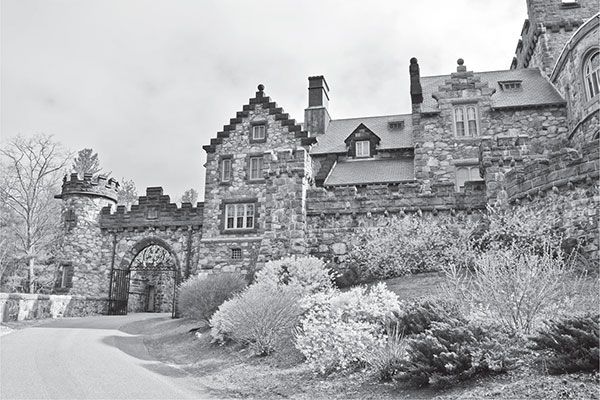
The front of Searles Castle as seen from the path leading to the iron-gated entryway. Mark Cantrell.
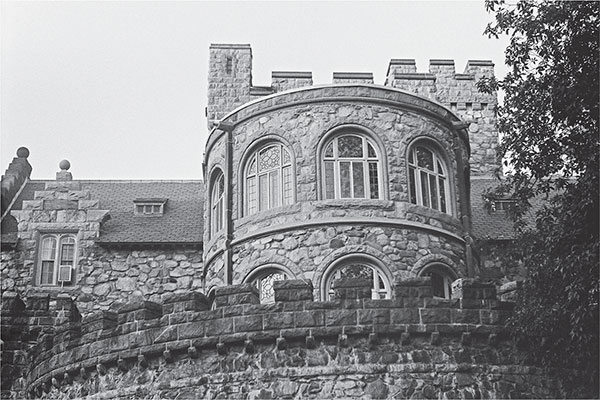
A wall built around the castle shielded the first floor from the prying eyes of the curious and gave the estate an authentic medieval appearance. Mark Cantrell.
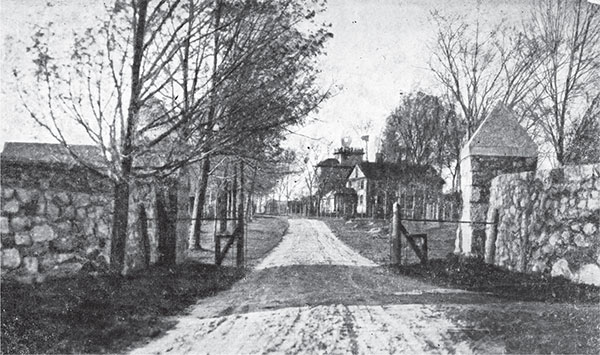
The gated entrance to Searles’s estate is where attendants would have waited for his arrival. Author’s collection.
Searles, who was accustomed to using his wealth to purchase whatever he wanted, encountered several problems in Windham. First, he greatly desired to purchase a piece of land located between Range Road and the original Indian Rock Road. However, the owner, Dan Roy, would not sell. Searles responded by building a wall around one side of the desired property and purchasing property that abutted the other three sides. Roy never gave in, leaving Searles to move on to other endeavors.
A second issue arose when Searles had acquired land, which surrounded School House No. 1. As it was important for Searles to have control of the entire property, he offered the town a new schoolhouse and the land on which it would be built in exchange for the old schoolhouse. This time, Searles met little resistance and built the town a $40,000 Tudor-style schoolhouse, with the provision that it could be used only for educational or religious purposes.
Searles’s accumulation of New Hampshire property proved to be in vain, for he was taxed in 1913 on his cash assets, which represented much of his fortune. As the value of Searles’s estate dwarfed that of the entire population of Windham, the tax rate significantly dropped to about $0.55 per $1,000.00. The town also had to deal with a new problem it had not previously run into: what would the tax windfall be used for?
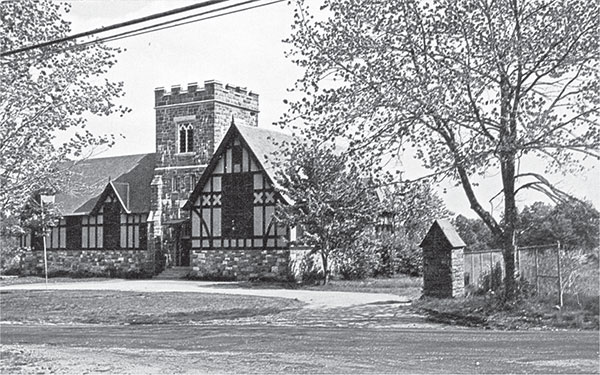
The school Searles built for the town in exchange for Schoolhouse No. 1. Author’s collection.
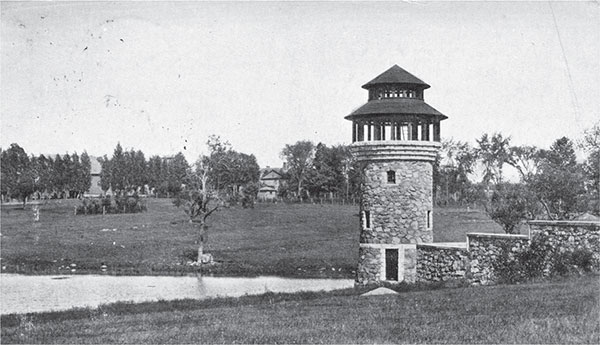
A circa 1920 postcard showing one of the large stone towers constructed on the Searles estate. Author’s collection .
The town’s selectmen decided and the voters agreed that the money would be best put to use for roadwork. To complete the work, a steamroller and stone crusher were purchased with the intention of working near Windham Depot and on Kendall Pond Road. However, the construction workers were more focused on play than work and would take time off to play a game of baseball whenever they felt the urge to. Also, Searles left town in 1914 because of the taxes, leaving Windham without the tax revenue to finish the project. After leaving town, Searles purchased Rockingham Park in Salem.
Searles died at the age of seventy-nine on August 6, 1920, at his estate in Methuen. His funeral was held the following Tuesday, with 150 guests in attendance, including relatives and employees. Keeping with Searles’s distaste for publicity, no newspaper reporters were allowed admittance to the services, which were held in the great hall of Pine Lodge. The body of Searles remained hidden from view in a closed casket, denying guests a final glimpse of the eccentric millionaire. Although there were later rumors of murder by poisoning, these were dispelled when his tomb was opened and an autopsy was performed.